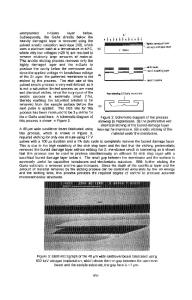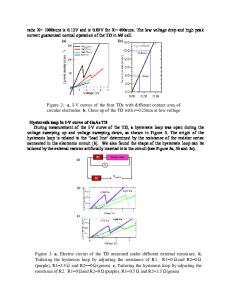Fabrication of CNT/metal torsional resonator structures on GaAs
- PDF / 636,722 Bytes
- 6 Pages / 612 x 792 pts (letter) Page_size
- 69 Downloads / 283 Views
1018-EE08-12
Fabrication of CNT/metal torsional resonator structures on GaAs Seung Sae Hong1,2, Jung Hoon Bak1,2, Byung Yang Lee2, Sung Woon Cho1,2, Young Duck Kim1,2, Seunghun Hong2, and Yun Daniel Park1,2 1 CSCMR, Seoul National University, NS50, Seoul, 151-747, Korea, Republic of 2 Department of Physics and Astronomy, Seoul National University, NS50, Seoul, 151-747, Korea, Republic of ABSTRACT We present a method to realize nanoelectromechanical systems (NEMS) resonator structures from carbon nanotubes (CNT)/metal layered composite structures. The method utilizes a self aligning process over a near 2-D CNT network on GaAs to realize resonator structures and a highly selective etchant, a standard citric acid/hydrogen peroxide solution, to achieve release of NEMS resonators from the substrate. We find this method along with critical point drying (CPD) to yield robust hybrid CNT/metal resonator structures with fundamental resonant frequencies in the 10 MHz range. With high reflectivity, conductivity, and biocompatibility of metals, this fabrication method along with possible benefits of CNT have many application possibilities.
INTRODUCTION Carbon nanotubes (CNT) have been known for its great potential as a future building block for nanoelectronics[1-4], with CNTís unique electrical and mechanical properties. Also, nano electromechanical systems (NEMS) structures due to its size allows for unprecedented force sensitivities to study quantum mechanical phenomenon in macroscopic scale. In that, NEMS structure combined with CNT can be applied to elucidate the nanotubeís physical properties as well as further applications[5-7]. Although individual single-wall carbon nanotube and multi-wall nanotube have been utilized to demonstrate NEMS structure, top-down techniques have been limited to fundamental research due to the difficulty in handling single nanotubes. Although NEMS structures, as well as majority of MEMS (micro electromechanical systems), has been focused on Si based materials and processing[8, 9], metallic NEMS/MEMS structures are of possible interest due to its high reflectivity, conductance, and bio-compatibility. Such NEMS structures on GaAs has further advantage in that piezoelectric properties of GaAs can be incorporated for actuation and sensing as well as integration of high speed solid-state devices as well as optoelectronic devices are possible. Here, we will demonstrate a method to realize carbon nanotube NEMS structures on GaAs surface by adopting highly selective wet-etching and reactive ion etching techniques.
EXPERIMENT
Figure 1. Fabrication process: (a) Disperse sw-CNT on GaAs substrate. (b) Define metal pattern by e-beam lithography. (c) Define Al for etching mask. (d) Remove CNT on the substrate by reactive ion etching (SF6). (e) Remove Al mask. (f) Under-etch GaAs with citric acid and Hydrogen peroxide. Fabrication The fabrication scheme, illustrated in fig.1, begins with a preparation of a near 2-D single walled carbon nanotube (sw-CNT) on a semi-insulating (001) GaAs substrate. The GaAs s
Data Loading...











